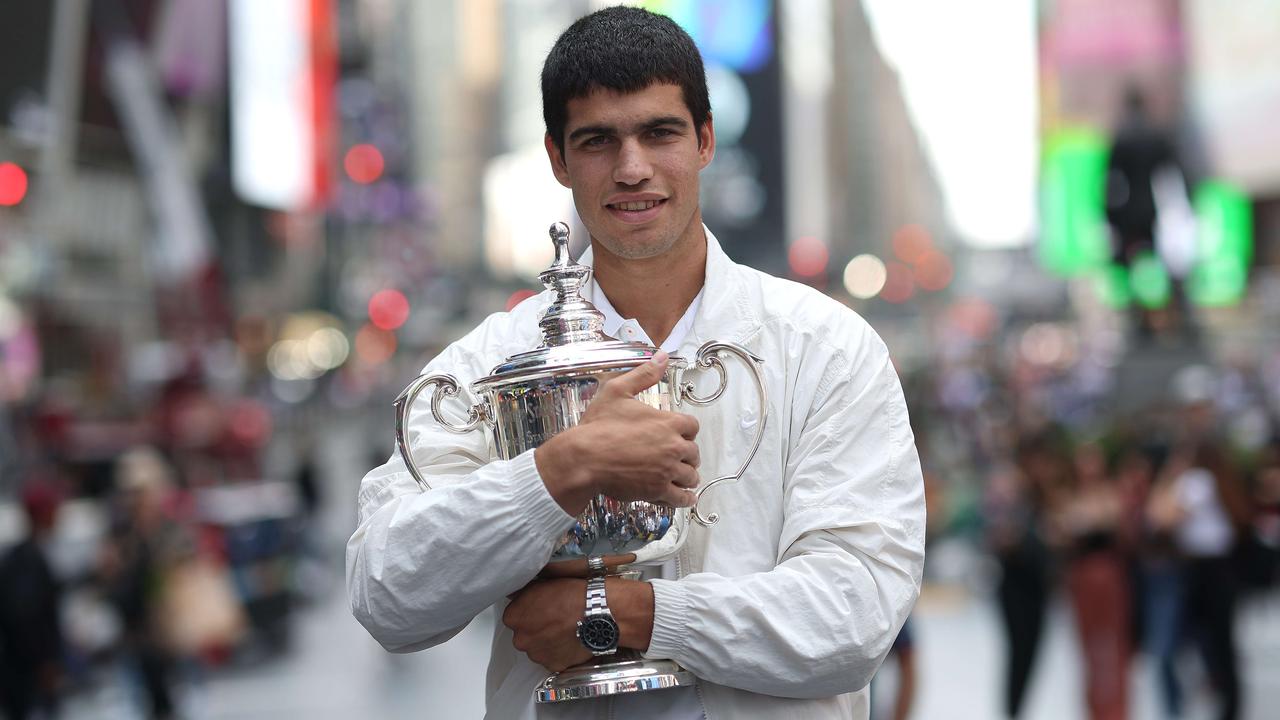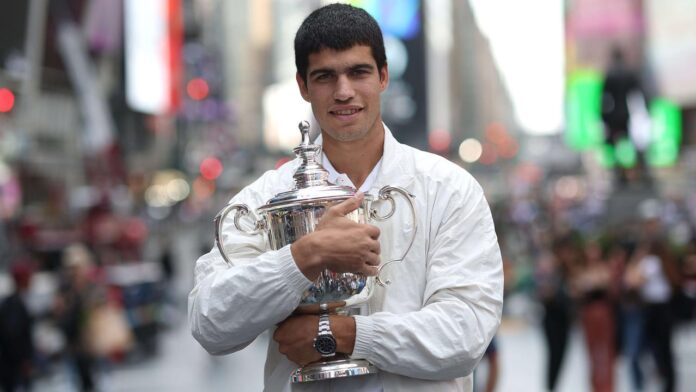
Carlos Alcaraz felt inevitable at the US Open. He felt like a beginning, right on time. A grand slam champion and world No.1 at age 19, he can now challenge the sport’s existing kings, writes JASON GAY.
Carlos Alcaraz felt inevitable at the 2022 U.S. Open. Maybe it was his five-set quarterfinal that ended triumphantly at the vampire’s hour of 2.50am; maybe it was the five-set marathon before that, which finished at a far more civilised 2.23am.
Maybe it was the way Alcaraz held off a furious comeback from U.S. comet Frances Tiafoe in Friday night’s noisy semi-final — and then, when it was over, classily yielded the microphone to Tiafoe to bid New York City a tearful adieu.
Alcaraz was ready and roaring for a breakthrough. Sunday night he did it, defeating Casper Ruud 6-4 2-6 7-6(1) 6-3 in a rollicking match that again showcased the 19-year-old Spaniard’s spectacular endurance and physical gifts.
It is the first major tournament victory of Alcaraz’s young career and vaults him, auspiciously, to the World No.1 ranking. He is the youngest No.1 since they began charting rankings in 1973.
Alcaraz feels right. And right on time.
Men’s tennis should be in a precarious position right now. The sport has spent a decade and a half watching its major trophies hoarded by a trio of all-time champions: Roger Federer, Rafael Nadal and Novak Djokovic. While the “Big Three” era is not over — it’s still raging against the dying of the light, the scalpels of the orthopaedics, and the travel restrictions of the CDC — there’s fear of a crashing letdown when these wizards finally hang it up. How can anyone else possibly compete?
Alcaraz, that’s how. Sunday night does not feel like a one-and-done. It feels like a beginning.
The teenager from El Palmar is a tornado of talent, to the point it’s physically exhausting just to watch him play. To see Alcaraz scamper east to west on the baseline — and then west to east — or bound like a bunny to the net is to be reminded what an outrageous weapon youth can be.
Consider a key moment in Sunday’s final, in the third set, tied 4-4 and 30-30 on Ruud’s serve. Ruud and Alcaraz embarked on another epic rally which ended with Alcaraz swatting a forehand down the line and sliding across the hard court on his belly, like Pete Rose taking third at Riverfront. Alcaraz’s shot landed just wide, giving Ruud a critical point.
And yet the teenager broke out into a wide grin, as if he couldn’t believe he missed.
Of course he couldn’t believe it — those shots often go in. Alcaraz plays circus tennis, running down balls almost everyone else surrenders to, throwing around his body in a way that recalls another teen wonder, Boris Becker, on the lawn at Wimbledon.
While it’s dangerous to confirm a young tennis superstar — the practice courts are strewn with the epitaphs of phenoms burned by injuries and expectations — there’s no player in the sport with his electrifying package. Alcaraz is now destination tennis, right up there with Nadal, Djokovic, and 41-year-old Fed if and when he returns.
They knew it in New York, where they came ready for a coronation. The 23-year-old Ruud is no slouch — he also would have been crowned World No.1 had he prevailed. But Alcaraz had spent the better part of two weeks building a reputation via giddy highlights and last call victories. A tournament that began with a soaring farewell voyage for Serena Williams and peaked again Saturday with a straight-sets women’s title for Iga Swiatek was ready to anoint the Next Big Thing.
Alcaraz delivered. There were moments Sunday when he looked gassed — a zillion hours of tennis in two weeks will do that to you — but he still pulled off most of his parlour tricks. He pinned Ruud back with ferocious, sharp angled ground strokes; he crashed the net for running volleys; he unleashed his gorgeous unicorn rainbow of a drop shot, a dropper so good it can only make an opponent laugh.
Does he have weaknesses? Sure. Alcaraz can mentally check out of his own matches — he did a little bit of that Sunday, letting Ruud regain momentum and nearly take a 2-1 set lead. In five-set tournaments he’s going to have to be more selective with his feats of athleticism — there will come a time when Alcaraz can’t count on his legs to bail him out of trouble.
But mostly you look at Alcaraz and think: phew. Up-and-coming tennis stars can be over the place emotionally, sometimes unravelling altogether. There was a minute during this tournament when Nick Kyrgios looked like the man to beat, and then he sank in a racket-cracking crumble. Alcaraz, by comparison, kept it steady. He didn’t eat himself up. Taking a page from the lions Roger, Rafa and Nole, he picked up and moved onto the next.
Regarding Djokovic: A few readers have argued to me that this year’s Open title somehow deserves an “asterisk” due to the absence of the recent Wimbledon champion, who could not enter the country due to the lingering prohibition on unvaccinated foreign travellers.
While I get the frustration that Djokovic wasn’t here — it is frustrating, given he was allowed to compete in New York in 2020 and 2021 and the travel restriction seems bound to be lifted any minute — assumptions about who wins what in tennis are a dubious business.
Djokovic surely would have been a contender here. But does his 2022 Wimbledon title deserve an asterisk because Daniil Medvedev, the then-World No.1, was banned from the major because he represents Russia? Absolutely not. Let’s leave the asterisks to the home run debates in Major League Baseball and keep them out of tennis.
Besides, they’re going to settle this down the road. Tennis has a way of figuring this out. Alcaraz is 1-0 lifetime against Djokovic; 1-2 against Nadal; he’s yet to meet Federer, who has missed many months recovering from a knee injury.
Don’t you want to see these valiant kings battle the prince? Is it too much to ask for? Men’s tennis has had an embarrassingly brilliant couple of decades. In Carlos Alcaraz, it now has its future.








